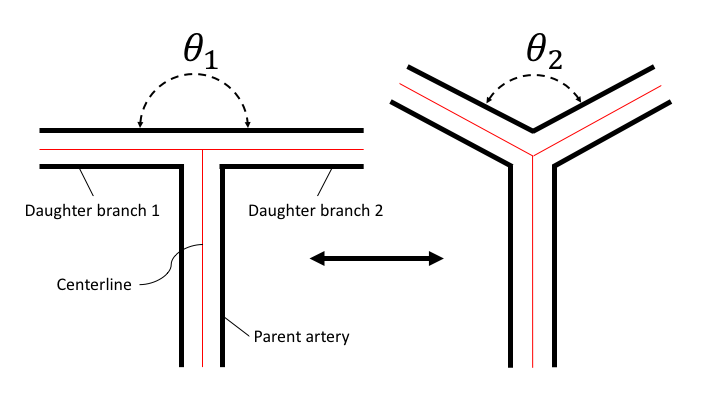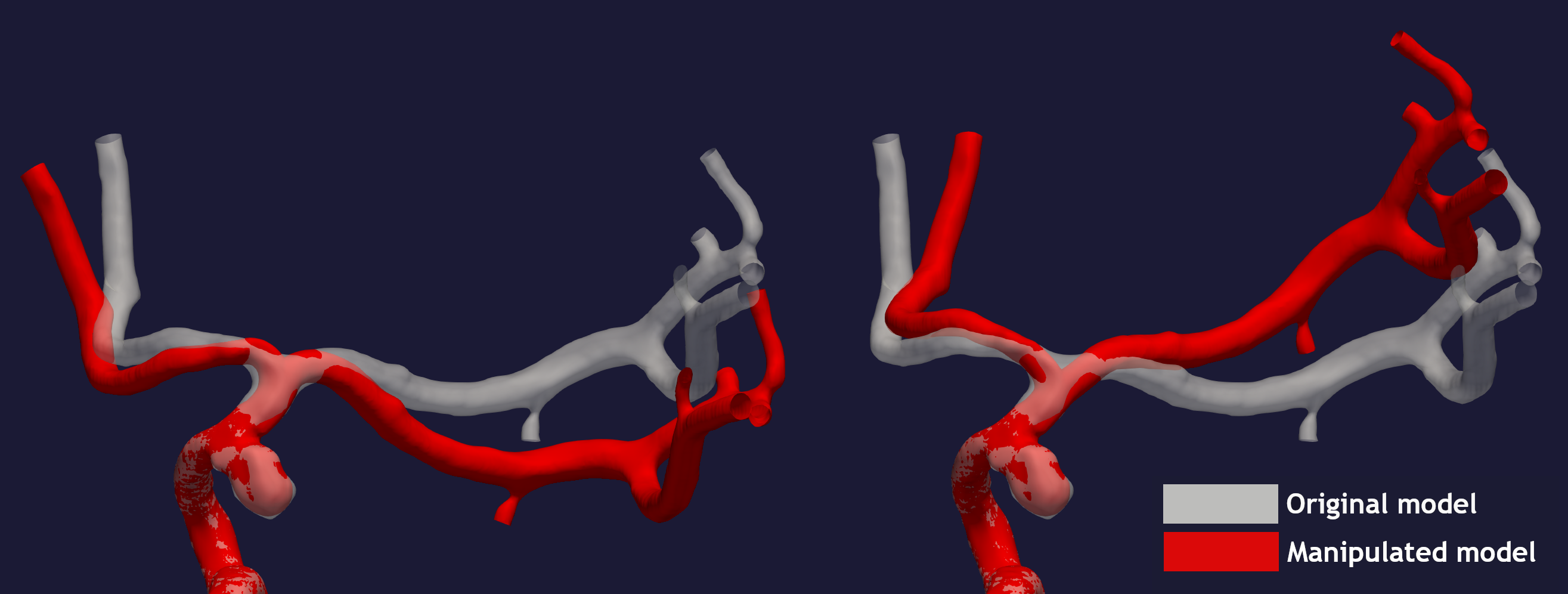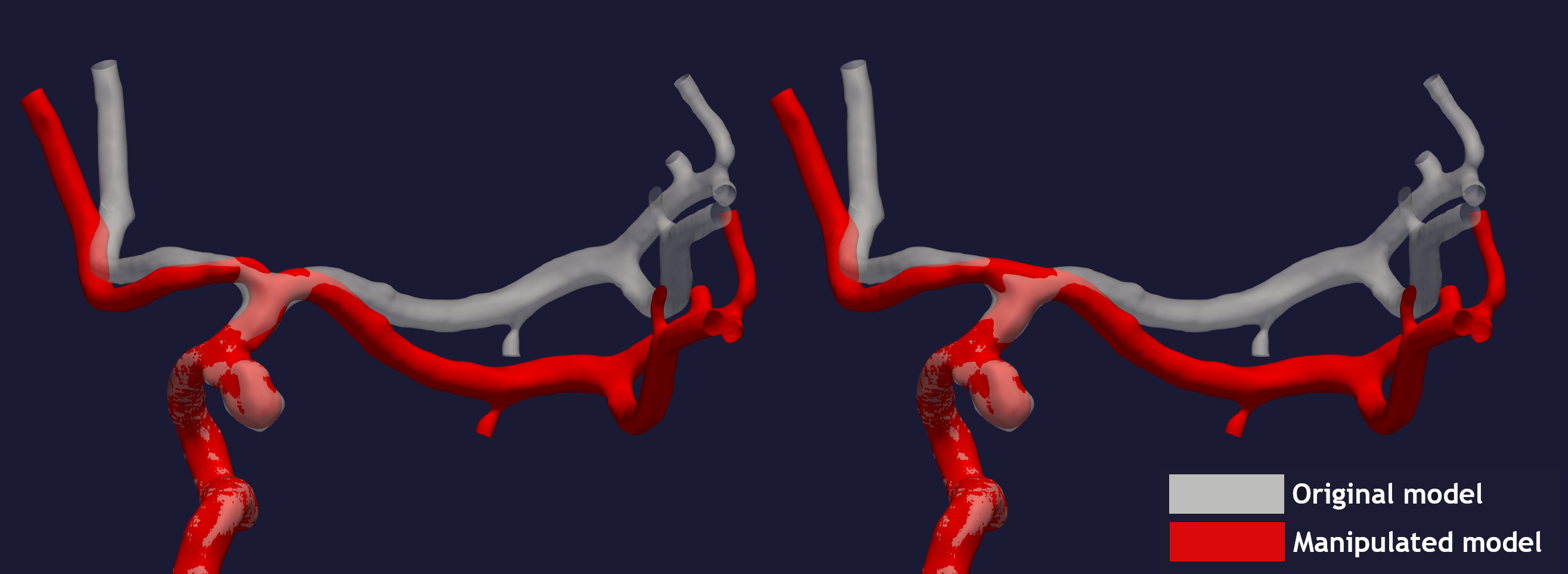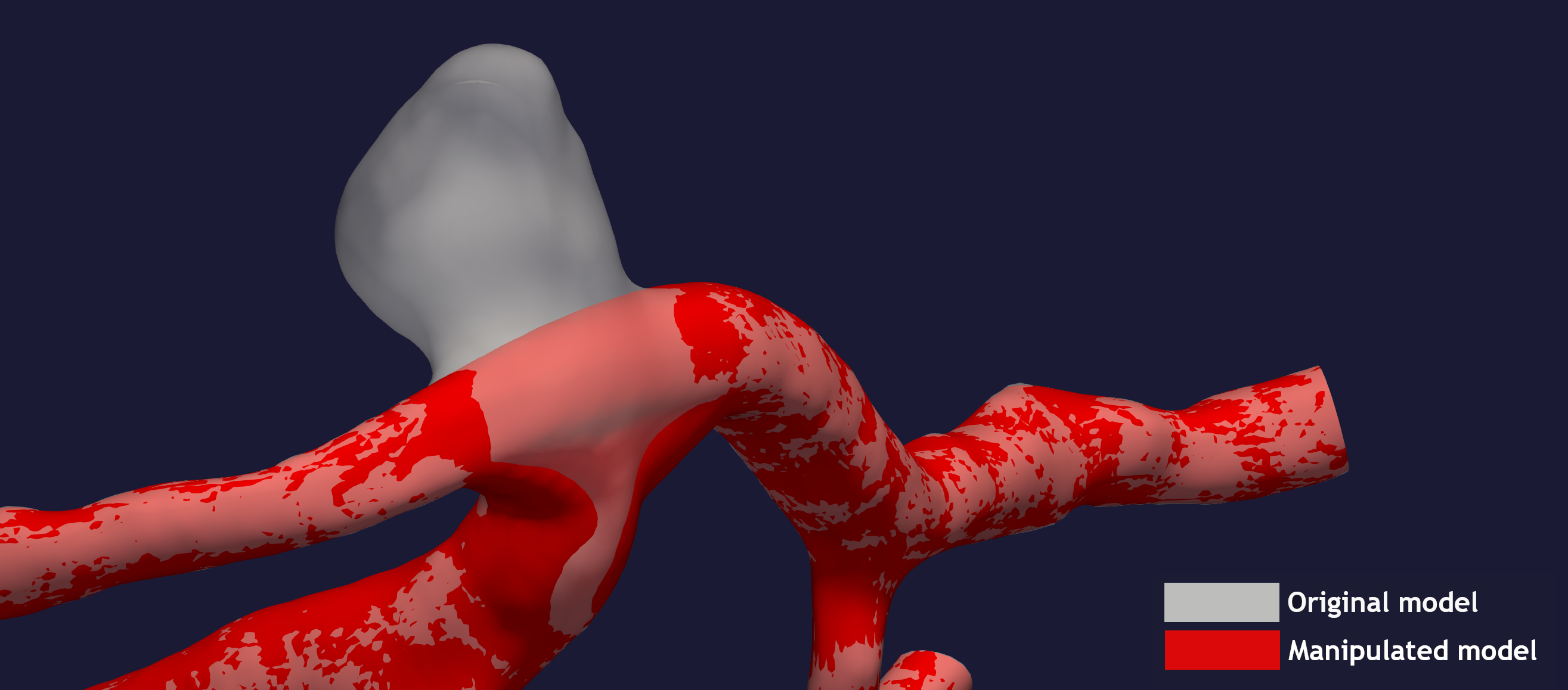Tutorial: Manipulate bifurcation¶
The goal with morphman-bifurcation is to control the angle between two
daughter branches in a bifurcation, see Figure 1. The daughter branches can be
rotated towards each other, in other words reduce \(\theta\), or towards
the parent artery, increasing \(\theta\). The naming convention is that the
largest daughter branch is numbered 1, and the smallest 2.
The algorithm builds on previous work of Ford et al. [1]

Figure 1: An illustration of the goal of morphman-bifurcation.
In this tutorial, we are using the model with
ID C0005
from the Aneurisk database. For the commands below we assume that there
is a file ./C0005/surface/model.vtp, relative to where you execute the command.
Performing the manipulation can be achieved by running morphman-bifurcation in the terminal, followed by the
respective command line arguments. Alternatively, you can execute the Python script directly,
located in the morphman subfolder, by typing python manipulate_bifurcation.py. We have also created a
demo folder where we show how to run this tutorial from a Python script, please check out the code from GitHub to
run the demos.
Shown in Figure 2 is the result of rotating the two daughter branches with both a positive and negative angle.

Figure 2: Rotation of daughter branches, in both a widening and narrowing of the bifurcation angle.
You can reproduce the results in Figure 2 by running the following command:
morphman-bifurcation --ifile C0005/surface/model.vtp --ofile C0005/surface/rotate_plus.vtp --angle 20 --region-of-interest commandline --region-points 43.2 70.5 26.4 84.4 60.6 50.6 --poly-ball-size 250 250 250
for narrowing of the bifurcation angle, and similarly for widening of the bifurcation angle:
morphman-bifurcation --ifile C0005/surface/model.vtp --ofile C0005/surface/rotate_minus.vtp --angle -20 --region-of-interest commandline --region-points 43.2 70.5 26.4 84.4 60.6 50.6 --poly-ball-size 250 250 250
Inspecting Figure 2 closely you can observe an unphysiological “notch” in the bifurcation of the surface
with increased \(\theta\). One remedy is to add the flag --bif True and --lower True,
which will output a smoother bifurcation, as shown on the right side in Figure 3, compared with a model with no flags.
The results shown in Figure 3 can reproduced by
running the command:
morphman-bifurcation --ifile C0005/surface/model.vtp --ofile C0005/surface/rotate_no_notch.vtp --angle -20 --bif True --lower True --region-of-interest commandline --region-points 43.2 70.5 26.4 84.4 60.6 50.6 --poly-ball-size 250 250 250
Using both flags have proven to give an improved surface, and when used for computational fluid dynamics, a more physiological plausible wall shear stress [2].

Figure 3: Rotation of daughter branches with a different reconstruction of the bifurcation.
The default is to rotate both branches, but if either --keep-fixed-1 or
--keep-fixed-2 is set to True, daughter branch 1 or 2 will be kept
fixed, respectively. Furthermore, if both parameters are set to True
then the algorithm can be used to remove an aneurysm (a balloon-shaped bleb
on the artery), see Figure 4. To this specific tutorial, we have used the model
with ID C0066
, which harbors an aneurysm located at the terminal bifurcation in the internal carotid artery.

Figure 4: Remove an aneurysm from the bifurcation.
To reproduce the result shown in Figure 4, you can run the following command:
morphman-bifurcation --ifile C0066/surface/model.vtp --ofile C0066/surface/removed_aneurysm.vtp --keep-fixed-1 True --keep-fixed-2 True --bif True --lower True --angle 0 --region-of-interest commandline --region-points 31.37 60.65 25.21 67.81 43.08 41.24 --poly-ball-size 250 250 250
For additional information, beyond this tutorial, on the script and
input parameters, please run morphman-bifurcation -h or confer with
the manipulate_bifurcation().
| [1] | Ford, M.D., Hoi, Y., Piccinelli, M., Antiga, L. and Steinman, D.A., 2009. An objective approach to digital removal of saccular aneurysms: technique and applications. The British Journal of Radiology, 82(special_issue_1), pp.S55-S61. |
| [2] | Bergersen, A.W., Chnafa, C., Piccinelli, M., Gallo, C., Steinman, D.A., and Valen-Sendstad, K. In preparation. Automated and Objective Removal of Bifurcation Aneurysms: Incremental Improvements? |